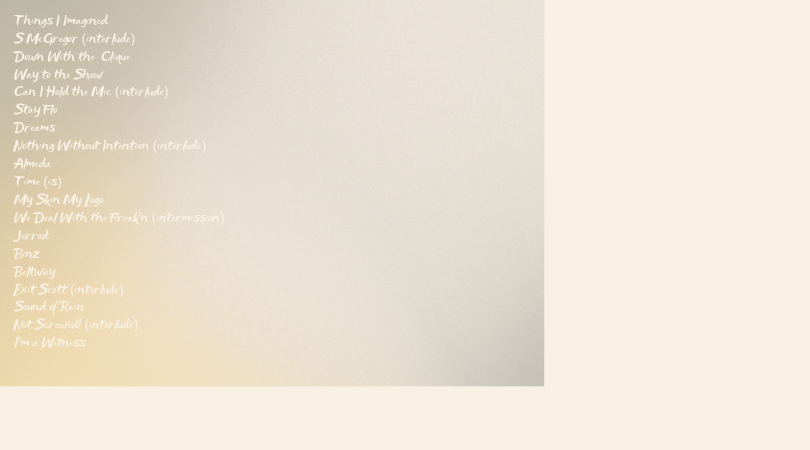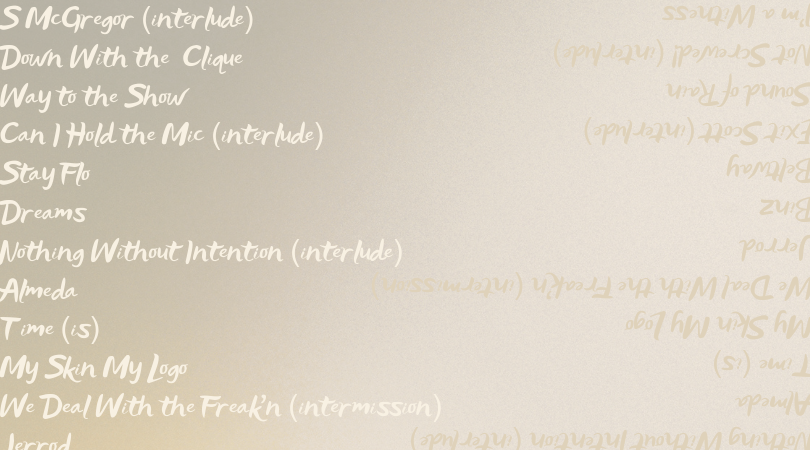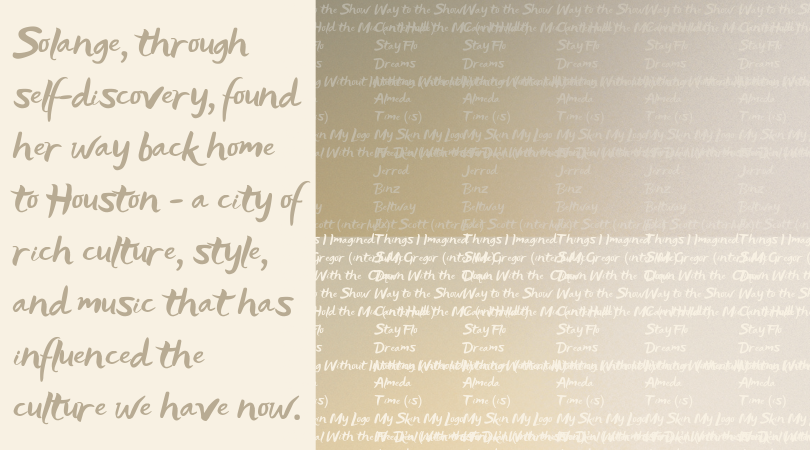Review: Too Many Parts, Too Many Spaces, Too Many Manifestations- A Month of “When I Get Home”
Words by Jada Gordon
Illustrations by Katie Herchenroeder
On the intersection of the end of Black History Month and the beginning of Women's History Month, Solange took us listeners on another journey. "When I Get Home" is, at its core, a nineteen track homage to Black feminism and womanism, a showcase of Solange’s experimental musical taste and ability, and the Houston of Solange’s mind.
As a listener and fan of Solange, one can only expect the unexpected. Solange's musical repertoire is so vast and fascinating, one can sit on the edge of their seats waiting for what she is going to deliver. So when the internet caught wind that Solange was releasing a project, fans were ecstatic. Not only because she was releasing an album after a four-year absence, but because of the interesting roll out.
In anticipation of the album, Solange brought back a social media platform made for black people in the early 2000s named Black Planet. Within it, were what looked like security clips of women and men waking, dancing, and living freely. The next day on her Instagram, she posted a video of her singing what would be the song "Way to the Show" with a phone number in the caption. It was an homage to fellow Houston rapper Mike Jones who used this phone number as the tagline of his piece. This was small way to shout out her hometown of Houston and its rap culture. With "When I Get Home," we listen and see how much home means to her and what it means to us as well.

The album is noticeably different from her transformative 2016 effort, “A Seat at the Table,” even from the album covers. Both show Solange in a white or off white backdrop, staring directly into the camera. However, the “When I Get Home” cover has Solange in a long, straight black hairstyle, with afro-futuristic glasses. Her eyes seem to sit low and disconnected but not disconnected enough to look the listener in their eye. “When I Get Home” is musically more subdued and nonlinear. The lyrics are repeated and the melodies and production are simple artistic touches to Solange’s soulful yet spacy vocal delivery.
Songs like the opener, “Things I imagined,” repeat the phrase “I saw things….I imagined/Things...Imagined” while the synth melody that wraps around Solange’s repetitious vocals progresses into a somewhat grand opening. This repetition welcomes the listeners to the experience that is “When I Get Home.”
The songs, along with the accompanying videos, all seem to move in a circular motion. This movement is done with intention and from what we know of Solange’s music, especially with “When I Get Home,” nothing is done without intention. The lyrics are at times hard to hear, but they are repeated almost like mantras or lamentations. The repetition of the places one calls home shows that no matter how long or far we go, home changes but still stays the same. These places and experiences come full circle when one returns home. We see Solange confront and experience this circle, not only for herself, but for the world to step into this and experience their own cycles of home.

A perfect example of this is the song “Dreams.” “Dreams” lyrically repeats “Dreams/They come a long way/not today” while the low key production seems to make the song feel like a breezy drift or dream itself. Solange coos these words sweetly which add to the adolescent hopes for life that Solange is trying to paint for us. Even in the visual for the song, the subject is seen living and growing through a backyard; and at one point the roots and leaves consume the subject. Showing us that, subjectively, dreams are what ground us and consume us. Dreams can consume our being and either take us far or keep us grounded to our roots.
Solange welcomes a well rounded and diverse group of artists to this album: Earl Sweatshirt, Tyler The Creator, Abra, Cassie, Raphael Saadiq, and John Carroll Kirby as well as others. They help push along Solange’s vision and sound and are not credited as features, but are in the production and liner notes. A standout from the various editions and features to the album are “Almeda,” and the Gucci Mane-assisted “My Skin My Logo.” Solange and Gucci Mane trade verses where they talk about what one another likes in a very jovial yet sincere moment. Its jazzy melodic bass and synth - toward the end - almost makes it sound like an impromptu jam in the studio. Moreover, Solange and Gucci seem engrossed in the playful banter, thus making it a standout on the album.
“Almeda” is one of the standouts of the album because it sees Solange uncharacteristically - unlike the rest of the album - shouting and chanting about everything brown and black. This track was a collaboration of Solange, The-Dream, and Playboi Carti - quite the unlikely group of collaborators. It is one of the most straight-forward songs on the album. You have an idea of what this song is about and what it stands for.

This song was one of that had a clear reference to the chopped and screwed genre which is a staple in southern music and the southern culture. She chants “Black skin, black braids/Black waves, black days/Black baes, black things /These are black-owned things.” It almost harkens back to the loud and proud messages of each track in “A Seat at the Table.” “Almeda” takes another turn when, in the halfway point of the song, Playboi Carti jumps in and rhymes over the bass-heavy banger. Playboi Carti is so effortless and natural in this song; we see this unlikely trio of collaborators come together and make a standout track.
Although “When I Get Home” takes a nonlinear approach to its message and songcraft, one of the topics that remained relevant and powerful in this project is Black Feminism. One of the clear theses or ideas that chased this album was that southern Black Feminism is strong and thriving. The interludes include Phylicia Rashad and Debbie Allen, both Houston natives celebrating their Black womanhood as well as other folks. Solange, through self-discovery, found her way back home to Houston - a city of rich culture, style, and music that has influenced the culture we have now. This album, in short, is a celebration of Afrofuturism, Black Feminism, and home.





